Property Analysis of Slag Composite Concrete Using a Kinetic–Thermodynamic Hydration Model
Abstract
:1. Introduction
2. Hydration-Based Property Evaluation Model of Binary Blends of Cement–Slag
2.1. Cement Hydration Model
2.2. Reaction Model of Slag in Cement–Slag Composite
2.3. Interactions between Individual Reactions of Cement and Slag
2.4. Hydration Heat
2.5. Summary of the Proposed Model
3. Experimental Studies and Modeling
3.1. Materials and Methods
3.2. Experimental Results
3.3. Modeling
3.3.1. Kinetic Model
3.3.2. Thermodynamic Equilibrium Model
4. Discussion
5. Conclusions
- First, we performed an experimental study on the isothermal hydration heat of blends of cement–slag. As the replacement percentages of slag increased from 0% to 30% and 50%, the rate of hydration heat decreased. For specimens with 30% and 50% slag, the third peak for the dissolution of aluminum was much higher and sharper than the second peak. Moreover, using the experimental results for the isothermal heat of hydration, we determined the reaction extent of slag. The analysis found that, as the replacement percentage of slag increased, the reaction extent of the slag was reduced. In addition, because the proposed model covers the interactions between the individual reactions of slag and cement, the coefficients of the slag reaction model and the cement hydration model are constant for various mixtures.
- Second, during the isothermal calorimetry test, both cement hydration and slag reaction contribute to heat release. Because the proposed kinetic hydration model can separate the slag reaction from cement hydration, the contribution of the slag reaction on heat release can be determined. Moreover, the reaction degree of slag can be calculated. Thus, based on the use of the kinetic hydration model, the isothermal calorimetry test can be used as an indirect method for determining the reaction degree of slag.
- Third, the reaction extents of slag and cement were used as input parameters for the thermodynamic equilibrium model, and the phase assemblage of the hydration of cement–slag was determined. Using the experimental results for strength and the analysis results of GEM-Selektor, we found that the strength of paste is linearly dependent on the combined water content or CSH content. The coefficients of determination for the combined water-based strength model and the CSH-based strength model were 0.82 and 0.87, respectively. The combined water-based strength model cannot reflect the strength crossover between plain paste and blended paste, while the CSH-based strength model can reflect the strength crossover. The CSH-based strength model showed that as the slag content increased, the time of the strength crossover grew longer. Compared with the combined water content, the CSH content is more suitable for the evaluation of the strength of cement–slag blends.
- Fourth, the specific contributions of this study are summarized as follows: (1) we proposed a kinetic hydration model to evaluate the reaction extent of slag and cement based on an isothermal calorimetry test, (2) we used the calculation results of the kinetic hydration model as input data for a thermodynamic model and evaluated the phase assemblage of hydrating cement–slag composite, and (3) we evaluated the strength development of hardening concrete using phase assemblage of composite concrete.
Author Contributions
Funding
Institutional Review Board Statement
Informed Consent Statement
Data Availability Statement
Conflicts of Interest
References
- Amran, M.; Murali, G.; Khalid, N.H.A.; Fediuk, R.; Ozbakkaloglu, T.; Lee, Y.H.; Haruna, S.; Lee, Y.Y. Slag uses in making an ecofriendly and sustainable concrete: A review. Constr. Build. Mater. 2021, 272, 121942. [Google Scholar] [CrossRef]
- Ren, G.; Yao, B.; Huang, H.; Gao, X. Influence of sisal fibers on the mechanical performance of ultra-high performance concretes. Constr. Build. Mater. 2021, 286, 122958. [Google Scholar] [CrossRef]
- Bilal, H.; Chen, T.; Ren, M.; Gao, X.; Su, A. Influence of silica fume, metakaolin & SBR latex on strength and durability performance of pervious concrete. Constr. Build. Mater. 2021, 275, 122124. [Google Scholar] [CrossRef]
- Ren, M.; Wen, X.; Gao, X.; Liu, Y. Thermal and mechanical properties of ultra-high performance concrete incorporated with microencapsulated phase change material. Constr. Build. Mater. 2021, 273, 121714. [Google Scholar] [CrossRef]
- Erdoğan, S.T.; Koçak, T.Ç. Influence of slag fineness on the strength and heat evolution of multiple-clinker blended cements. Constr. Build. Mater. 2017, 155, 800–810. [Google Scholar] [CrossRef]
- Lumley, J.S.; Gollop, R.S.; Moir, G.K.; Taylor, H.F.W. Degrees of reaction of the slag in some blends with portland cements. Cem. Concr. Res. 1996, 26, 139–151. [Google Scholar] [CrossRef]
- Iyoda, T.; Inokuchi, K.; Uomoto, T. Effect on slag hydration of blast-furnace slag cement in different curing conditions. In Proceedings of 13th International Congress on the Chemistry of Cement, Madrid, Spain, 3–8 July 2011. [Google Scholar]
- Liu, Z.; El-Tawil, S.; Hansen, W.; Wang, F. Effect of slag cement on the properties of ultra-high performance concrete. Constr. Build. Mater. 2018, 190, 830–837. [Google Scholar] [CrossRef]
- Castellano, C.C.; Bonavetti, V.L.; Donza, H.A.; Irassar, E.F. The effect of w/b and temperature on the hydration and strength of blastfurnace slag cements. Constr. Build. Mater. 2016, 111, 679–688. [Google Scholar] [CrossRef]
- Kim, Y.; Hanif, A.; Usman, M.; Munir, M.J.; Kazmi, S.M.S.; Kim, S. Slag waste incorporation in high early strength concrete as cement replacement: Environmental impact and influence on hydration & durability attributes. J. Clean. Prod. 2018, 172, 3056–3065. [Google Scholar] [CrossRef]
- Bougara, A.; Lynsdale, C.; Milestone, N.B. The influence of slag properties, mix parameters and curing temperature on hydration and strength development of slag/cement blends. Constr. Build. Mater. 2018, 187, 339–347. [Google Scholar] [CrossRef]
- Kandiri, A.; Mohammadi Golafshani, E.; Behnood, A. Estimation of the compressive strength of concretes containing ground granulated blast furnace slag using hybridized multi-objective ANN and salp swarm algorithm. Constr. Build. Mater. 2020, 248, 118676. [Google Scholar] [CrossRef]
- Wan, S.; Zhou, X.; Zhou, M.; Han, Y.; Chen, Y.; Geng, J.; Wang, T.; Xu, S.; Qiu, Z.; Hou, H. Hydration characteristics and modeling of ternary system of municipal solid wastes incineration fly ash-blast furnace slag-cement. Constr. Build. Mater. 2018, 180, 154–166. [Google Scholar] [CrossRef]
- Tan, Z.; De Schutter, G.; Ye, G.; Gao, Y.; Machiels, L. Influence of particle size on the early hydration of slag particle activated by Ca(OH)2 solution. Constr. Build. Mater. 2014, 52, 488–493. [Google Scholar] [CrossRef]
- Xie, F.; Liu, Z.; Zhang, D.; Wang, J.; Huang, T.; Wang, D. Reaction kinetics and kinetics models of alkali activated phosphorus slag. Constr. Build. Mater. 2020, 237, 117728. [Google Scholar] [CrossRef]
- Fernández, Á.; Lothenbach, B.; Alonso, M.C.; García Calvo, J.L. Thermodynamic modelling of short and long term hydration of ternary binders. Influence of Portland cement composition and blast furnace slag content. Constr. Build. Mater. 2018, 166, 510–521. [Google Scholar] [CrossRef]
- Schöler, A.; Lothenbach, B.; Winnefeld, F.; Zajac, M. Hydration of quaternary Portland cement blends containing blast-furnace slag, siliceous fly ash and limestone powder. Cem. Concr. Compos. 2015, 55, 374–382. [Google Scholar] [CrossRef]
- Han, F.; Zhang, Z.; Wang, D.; Yan, P. Hydration kinetics of composite binder containing slag at different temperatures. J. Therm. Anal. Calorim. 2015, 121, 815–827. [Google Scholar] [CrossRef]
- Gruyaert, E.; Robeyst, N.; De Belie, N. Study of the hydration of Portland cement blended with blast-furnace slag by calorimetry and thermogravimetry. J. Therm. Anal. Calorim. 2010, 102, 941–951. [Google Scholar] [CrossRef]
- Lee, H.S.; Wang, X.Y.; Zhang, L.N.; Koh, K.T. Analysis of the Optimum Usage of Slag for the Compressive Strength of Concrete. Materials 2015, 8, 1213–1229. [Google Scholar] [CrossRef] [PubMed]
- Lee, H.-S.; Wang, X.-Y. Hydration Model and Evaluation of the Properties of Calcined Hwangtoh Binary Blends. Int. J. Concr. Struct. Mater. 2021, 15, 11. [Google Scholar] [CrossRef]
- Maekawa, K.; Ishida, T.; Kishi, T. Multi-Scale Modeling of Structural Concrete; Taylor & Francis: London, UK; New York, NY, USA, 2009. [Google Scholar]
- Thomas, M. Supplementary Cementing Materials in Concrete; CRC Press: Boca Raton, FL, USA, 2013. [Google Scholar]
- Wang, X.-Y.; Luan, Y. Modeling of Hydration, Strength Development, and Optimum Combinations of Cement-Slag-Limestone Ternary Concrete. Int. J. Concr. Struct. Mater. 2018, 12, 12. [Google Scholar] [CrossRef] [Green Version]
- Ishida, T.; Luan, Y.; Sagawa, T.; Nawa, T. Modeling of early age behavior of blast furnace slag concrete based on micro-physical properties. Cem. Concr. Res. 2011, 41, 1357–1367. [Google Scholar] [CrossRef]
- Luan, Y.; Ishida, T.; Nawa, T.; Sagawa, T. Enhanced Model and Simulation of Hydration Process of Blast Furnace Slag in Blended Cement. J. Adv. Concr. Technol. 2012, 10, 1–13. [Google Scholar] [CrossRef] [Green Version]
- Park, S.; Abate, S.Y.; Kim, H.-K. Hydration kinetics modeling of sodium silicate-activated slag: A comparative study. Constr. Build. Mater. 2020, 242, 118144. [Google Scholar] [CrossRef]
- Cho, H.-K. A Study on the Prediction Model of Concrete Carbonation Using Cement Hydration Model Incorporating Ground Granulated Blast Furnace Slag. Ph.D. Thesis, Hanyang University, Seoul, Korea, 2015. [Google Scholar]
- Feng, X.; Garboczi, E.J.; Bentz, D.P.; Stutzman, P.E.; Mason, T.O. Estimation of the degree of hydration of blended cement pastes by a scanning electron microscope point-counting procedure. Cem. Concr. Res. 2004, 34, 1787–1793. [Google Scholar] [CrossRef]
- Kocaba, V.; Gallucci, E.; Scrivener, K.L. Methods for determination of degree of reaction of slag in blended cement pastes. Cem. Concr. Res. 2012, 42, 511–525. [Google Scholar] [CrossRef]
- Yio, M.H.N.; Phelan, J.C.; Wong, H.S.; Buenfeld, N.R. Determining the slag fraction, water/binder ratio and degree of hydration in hardened cement pastes. Cem. Concr. Res. 2014, 56, 171–181. [Google Scholar] [CrossRef] [Green Version]
- Lee, H.-S.; Lim, S.-M.; Wang, X.-Y. Optimal Mixture Design of Low-CO2 High-Volume Slag Concrete Considering Climate Change and CO2 Uptake. Int. J. Concr. Struct. Mater. 2019, 13, 56. [Google Scholar] [CrossRef]
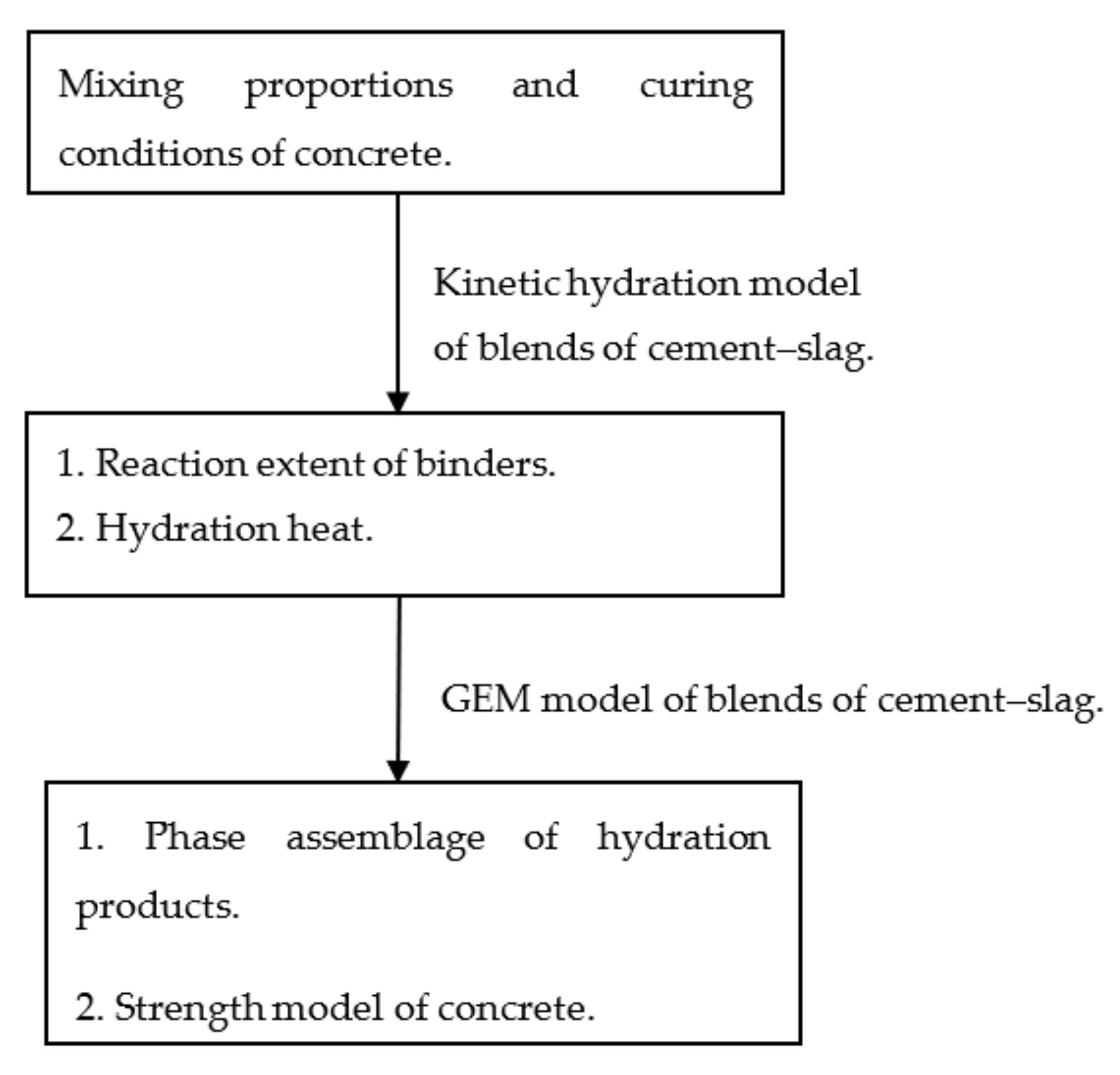
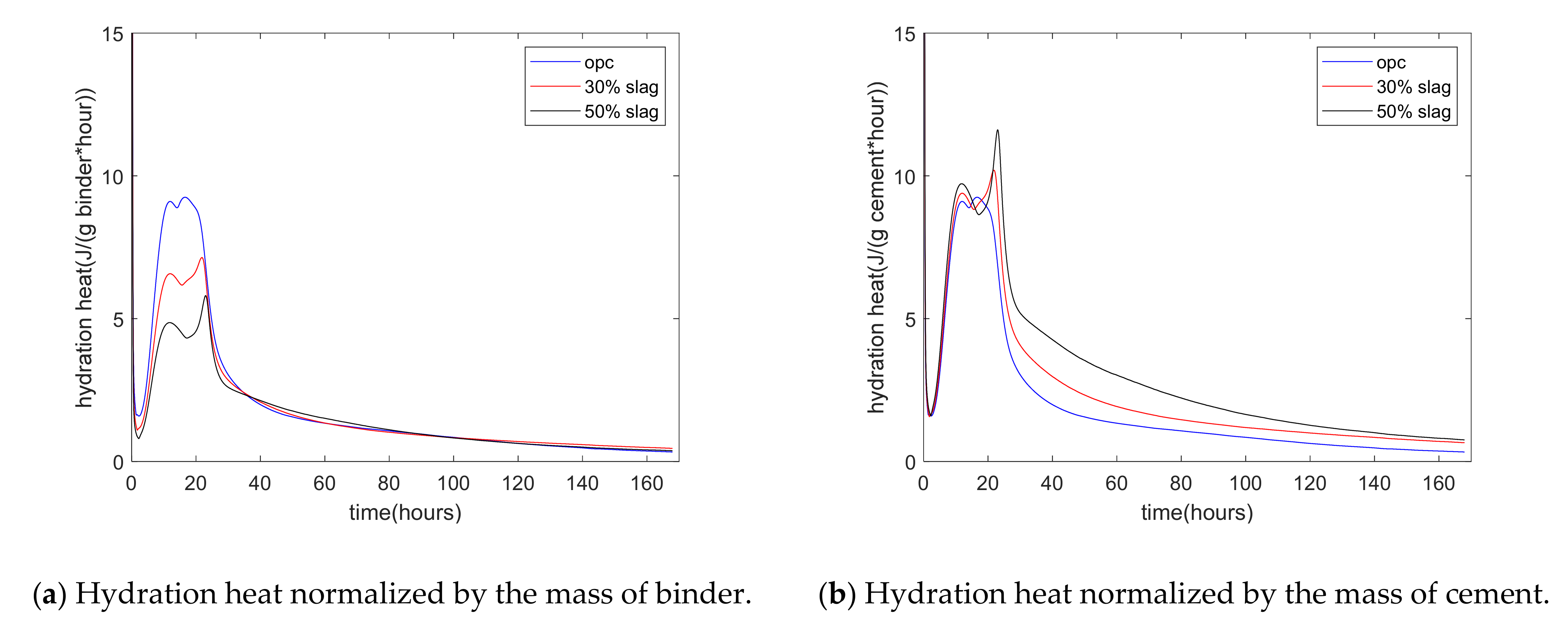
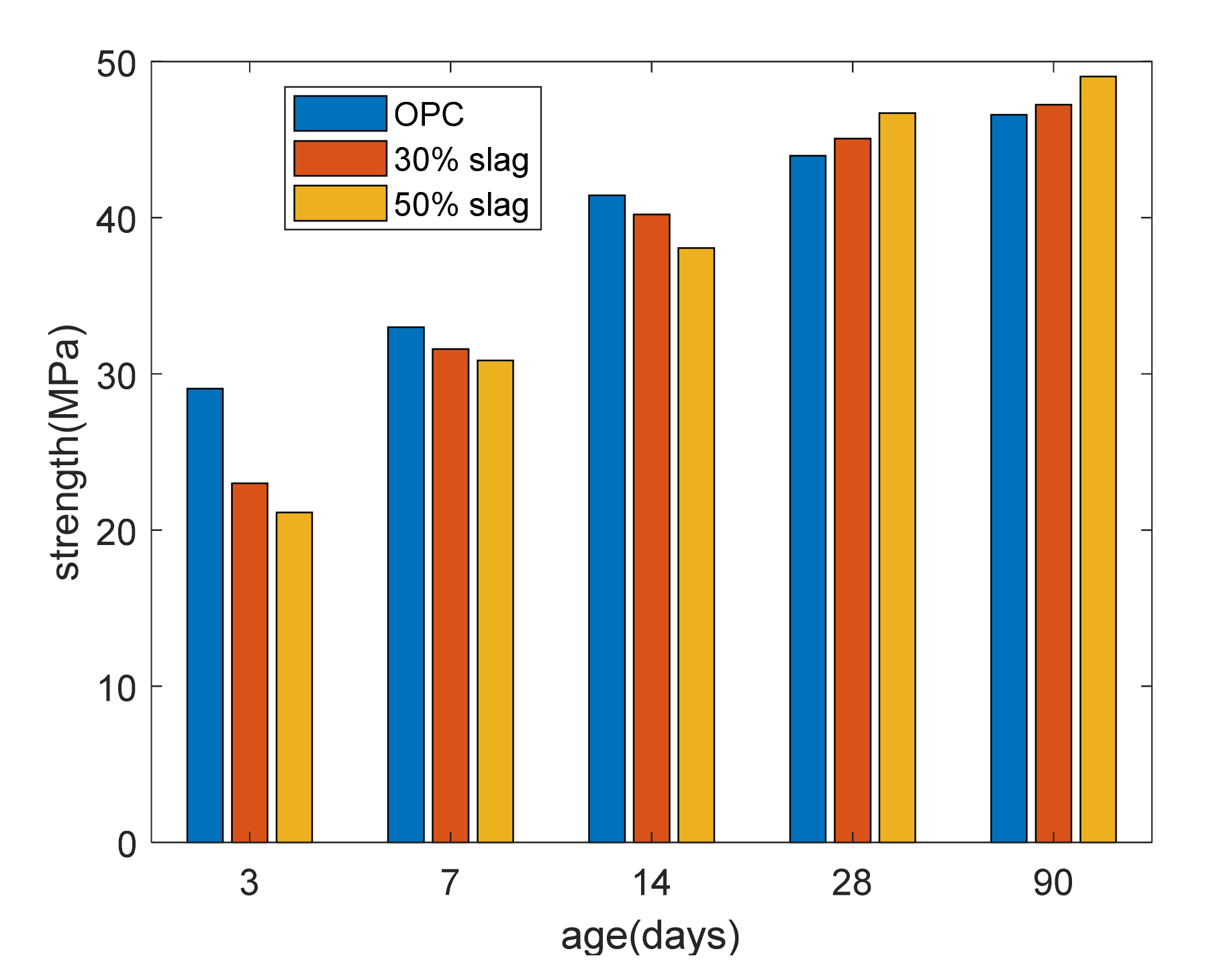
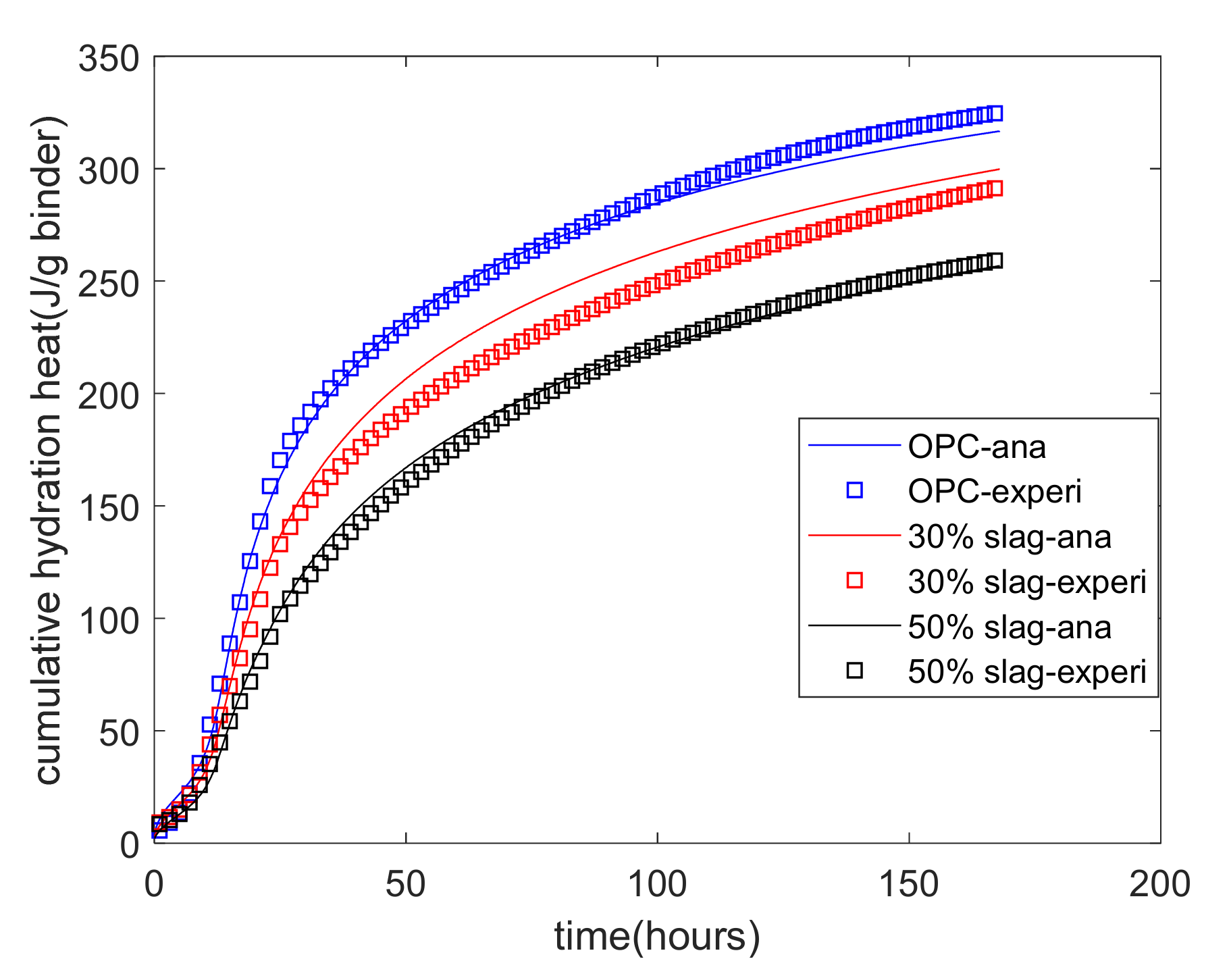

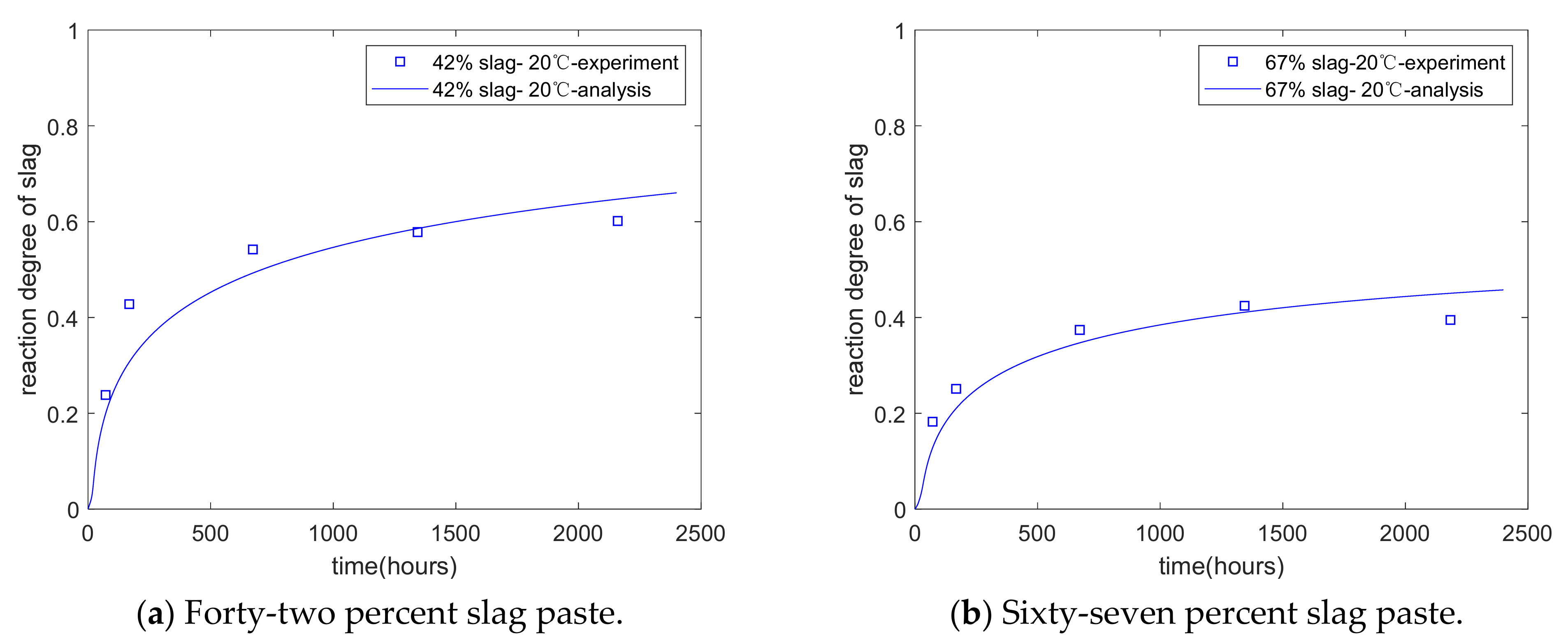
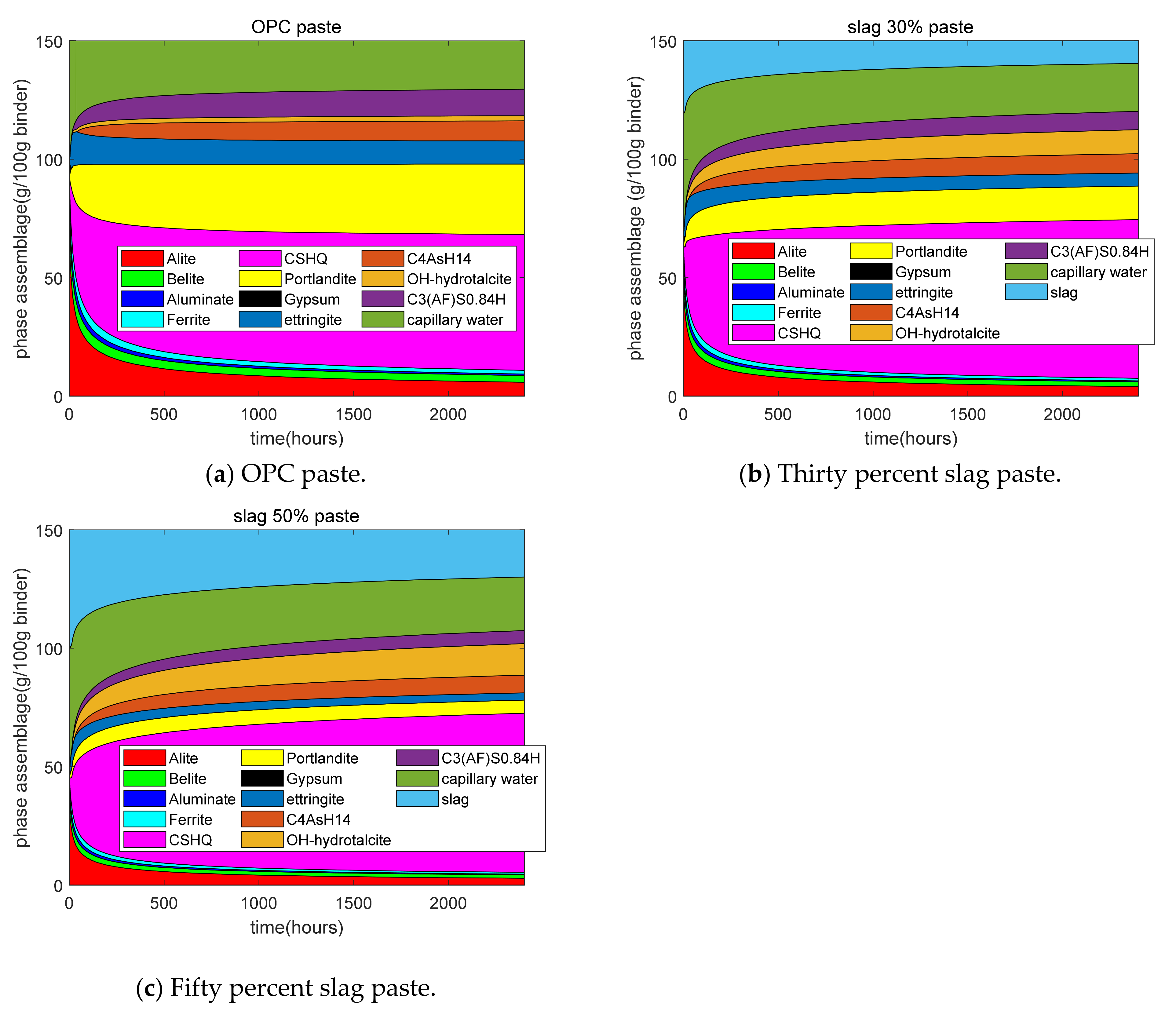
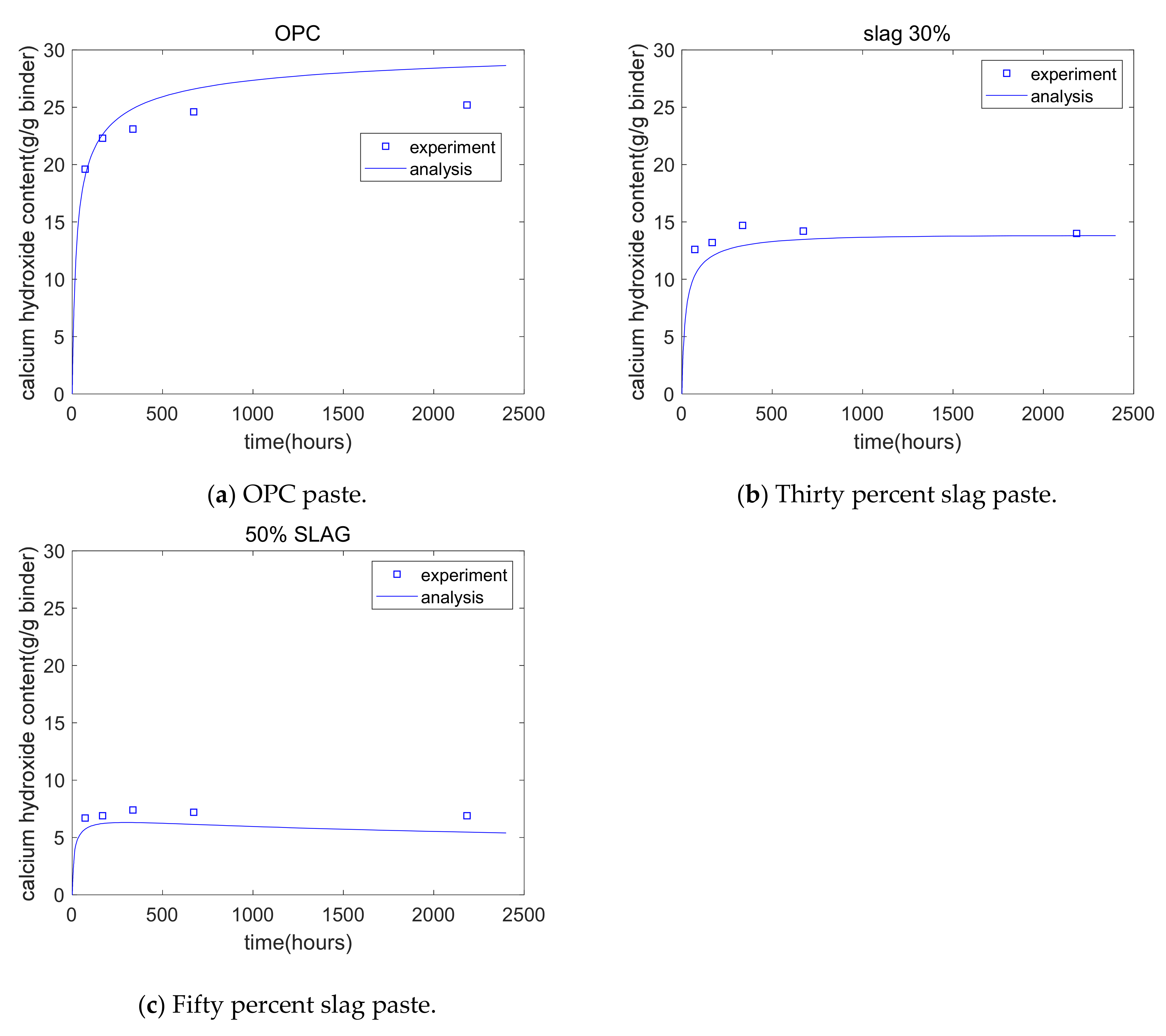

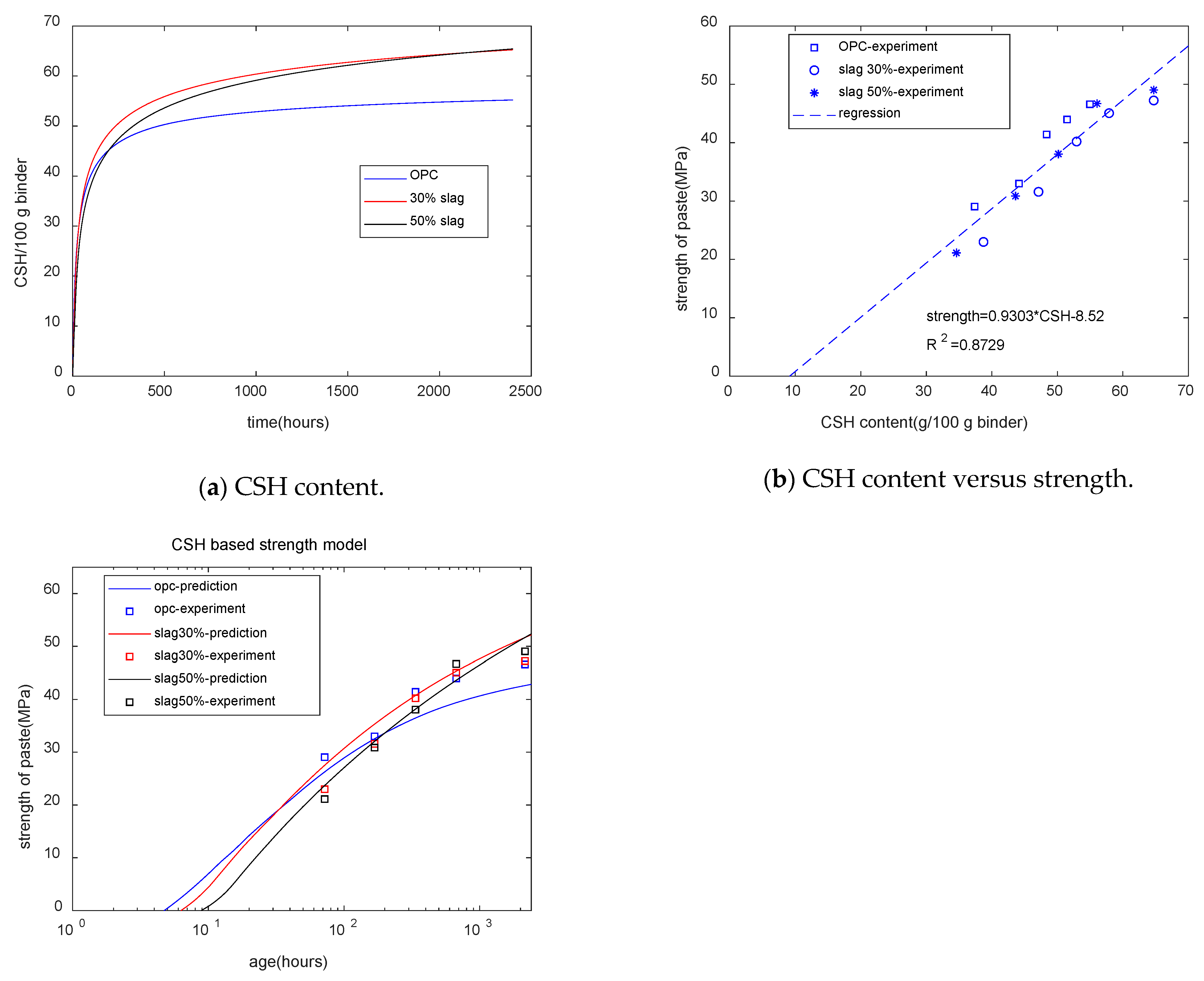
| CaO | SiO2 | Al2O3 | Fe2O3 | MgO | SO3 | Na2O | TiO2 | Loss on Ignition | |
|---|---|---|---|---|---|---|---|---|---|
| Cement | 64.7 | 21.1 | 5.77 | 3.14 | 0.89 | 1.61 | 0.25 | 0.22 | 2.32 |
| Slag | 34.63 | 35.85 | 9.79 | 0.46 | 13.84 | 3.45 | 0.35 | 0.62 | 1.01 |
| Fineness (cm2/g) | Specific Gravity | |
|---|---|---|
| Cement | 3300 | 3.15 |
| Slag | 4500 | 2.90 |
| Slag Replacement Percentages | Water/Binder Ratio | Curing Temperature | Isothermal Calorimetry Tests | Strength Tests |
|---|---|---|---|---|
| 0 | 0.5 | 20 °C | From mixing time to 7 days | 3, 7, 14, 28, and 90 days |
| 30% | ||||
| 50% |
| (cm/h) | (cm/h) | (cm/h) | (cm2/h) |
|---|---|---|---|
| 8.93 × 10−9 | 0.10 | 1.0 × 10−5 | 1.86 × 10−11 |
Publisher’s Note: MDPI stays neutral with regard to jurisdictional claims in published maps and institutional affiliations. |
© 2021 by the authors. Licensee MDPI, Basel, Switzerland. This article is an open access article distributed under the terms and conditions of the Creative Commons Attribution (CC BY) license (https://creativecommons.org/licenses/by/4.0/).
Share and Cite
Park, K.-B.; Wang, Y.-S.; Wang, X.-Y. Property Analysis of Slag Composite Concrete Using a Kinetic–Thermodynamic Hydration Model. Appl. Sci. 2021, 11, 7191. https://doi.org/10.3390/app11167191
Park K-B, Wang Y-S, Wang X-Y. Property Analysis of Slag Composite Concrete Using a Kinetic–Thermodynamic Hydration Model. Applied Sciences. 2021; 11(16):7191. https://doi.org/10.3390/app11167191
Chicago/Turabian StylePark, Ki-Bong, Yi-Sheng Wang, and Xiao-Yong Wang. 2021. "Property Analysis of Slag Composite Concrete Using a Kinetic–Thermodynamic Hydration Model" Applied Sciences 11, no. 16: 7191. https://doi.org/10.3390/app11167191
APA StylePark, K.-B., Wang, Y.-S., & Wang, X.-Y. (2021). Property Analysis of Slag Composite Concrete Using a Kinetic–Thermodynamic Hydration Model. Applied Sciences, 11(16), 7191. https://doi.org/10.3390/app11167191







